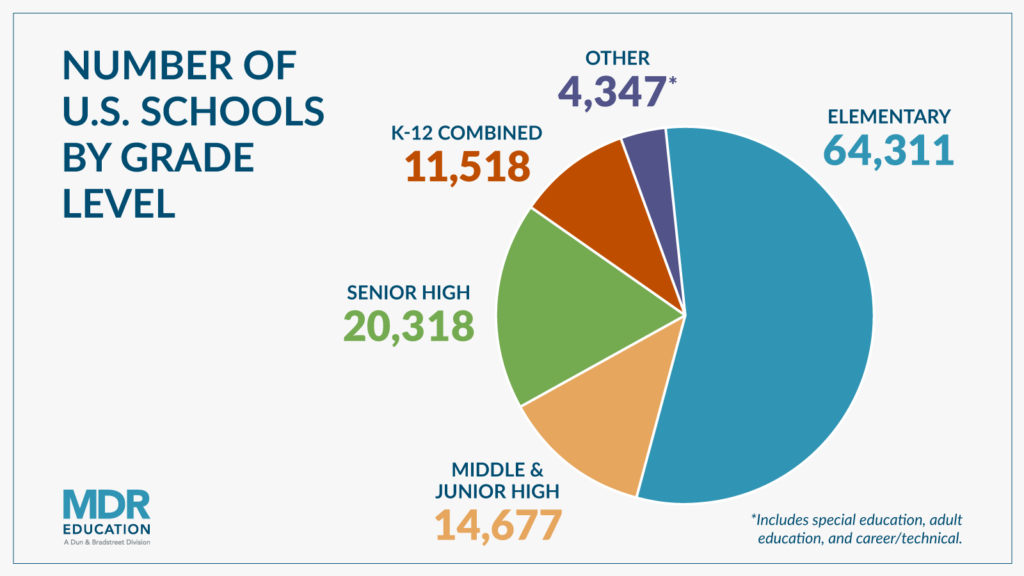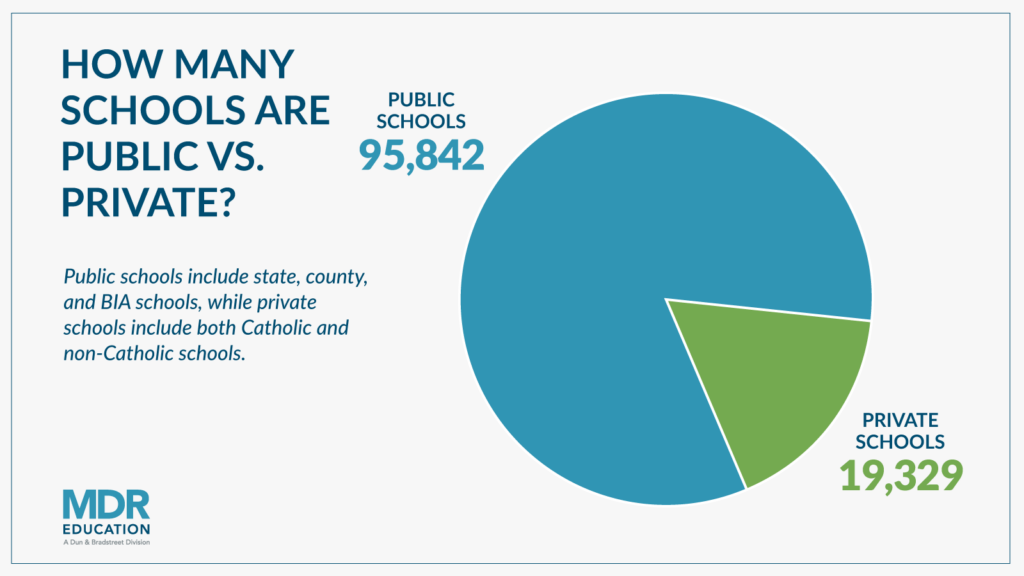
We’re breaking down the stats and looking at how many schools are private vs. public, the number of charter and magnet schools, the percentage of schools that fall under Title I, and much more.
The following data is from the MDR Data Cloud as of February 2024. You can use ConnectEd Cloud to build targeted email and direct mail lists for your sales and marketing teams. Search over 7.4M prospects and get detailed profiles of K-12 schools, districts and colleges.
How many schools are there in the U.S.?

All together, there are 115,171 schools in the United States. This includes all K-12 public and private schools, plus adult education and career/technical schools. With the current U.S. population of about 333 million people, that breaks down to one school for every 2,892 people.
Number of U.S. Schools by Grade Level

There are 11,518 public and private schools in the U.S. that cover all grades K-12 (that’s 10% of schools). Otherwise, most students attend schools broken down by grade level.
Elementary Schools
Elementary schools are generally defined as kindergarten through fifth grade, though some include sixth grade, and some continue to eighth grade. There are 64,311 elementary schools in the U.S., public and private. Many school districts have multiple “feeder” elementary schools whose students come together to attend larger middle and high schools.
Middle Schools
Middle schools and junior high schools serve students in between elementary and high school. Generally, a middle school serves sixth through eighth graders, while a junior high has only seventh and eighth graders. Some junior highs may also include ninth grade. In the U.S., there are 12,597 middle schools and 2,080 junior high schools, both public and private, for a total of 14,677 schools serving this age group.
High Schools
High schools (sometimes called senior high schools) usually cover ninth through twelfth grades, and there are a total of 20,318, both public and private, in the U.S. That’s about one high school for every 3.16 elementary schools.
State and County Schools
Many states operate educational organizations that provide instruction to the public, with 4,512 of these schools currently open in the U.S. These are primarily in the form of special services in special education or career and technical education, such as state-run schools for the deaf and the blind.
Individual counties within states may also run their own schools, often to provide special services such as special needs, adult, and career and technical education. Some county schools are administered by county superintendents’ offices; others are independent. The U.S. has 1,335 county schools.
Other Types of Schools in the U.S.

Special Education Schools
Special education schools serve students with special needs, such as learning, behavioral, or physical disabilities. While many students with disabilities attend their local public schools, some attend special schools that can better focus on helping them succeed. The U.S. has 2,671 special education schools, about 2% of the total number of schools.
Career and Technical Schools
Career and technical schools offer their students real-world job skills. These are often replacements for some or all the traditional high school years, with a goal of giving students hands-on experience so they’re ready to start their careers immediately after receiving their high school diploma. There are 1,266 career and technical schools in the country today.
Adult Education Schools
Some schools specifically serve adults instead of children. They may help students learn a new language, earn their GED, or explore enrichment topics. The U.S. has 410 schools specifically dedicated to adult education.
Public vs. Private Schools

There are 95,842 public schools in the U.S. This category includes organizations that provide free instruction to the public, operated by a public school district. These schools may be for elementary- and secondary-age children, adult education, career and technical education, and special needs students. Public schools make up 83% of all American schools.
Some federally funded public schools in the U.S. are located on Indian reservations and are run by local Native American tribal councils. These are known as Bureau of Indian Education (BIE) schools, and they’re part of the Bureau of Indian Affairs (BIA). There are 166 of these schools in the United States.
Private and Catholic schools account for about 17% of U.S. schools, with 13,871 private (non-Catholic) schools and 5,458 Catholic schools. These schools usually require students to pay tuition and may cover grades K-12, including special needs. They also include privately run career/technical and adult education organizations.
Charter and Magnet School Numbers
Magnet and charter schools are both publicly funded schools. Magnet schools are part of the traditional public school system, but they usually offer a specific focus on subjects like STEM or the performing arts. There are 2,079 magnet schools in the U.S., with 719 schools that focus specifically on STEM (science, technology, engineering, and math). They make up about 1.8% of public schools.
Charter schools are publicly funded but privately run. Rather than being bound by state education laws, these schools create their own contracts (known as “charters”). The U.S. currently has 8,427 charter schools, just over 7% of the total number of schools.
Other School Statistics

Title I Schools
Title I schools are those that receive additional federal funding from the U.S. Department of Education due to the high percentage of low-income families they serve. About 43% of public schools currently qualify for Title I funding, with a total of 49,229 schools benefiting from the program.
Blue Ribbon Schools
The U.S. Department of Education also recognizes Blue Ribbon schools. These include both public and private schools that either attain overall high academic achievement or help to close the achievement gap for under-achieving populations. Blue Ribbon schools are recognized once a year, with 353 named in the U.S. in 2023.
Year-Round Schools
Though most schools hold classes 180 days a year, with a substantial break during the summer, there are 2,041 year-round schools. That’s just under 2% of all U.S. schools.
Virtual Schools
Virtual schools have gained popularity in recent years. These schools are held entirely online and allow students to attend classes in an environment that suits their personal needs. There are 989 virtual schools currently open in the U.S.
MDR’s Data Cloud includes detailed information on K-12 schools. With this data, you can create marketing campaigns that will help you reach school leaders, teachers and districts who are best suited for your product or service. To learn more, reach out to us!